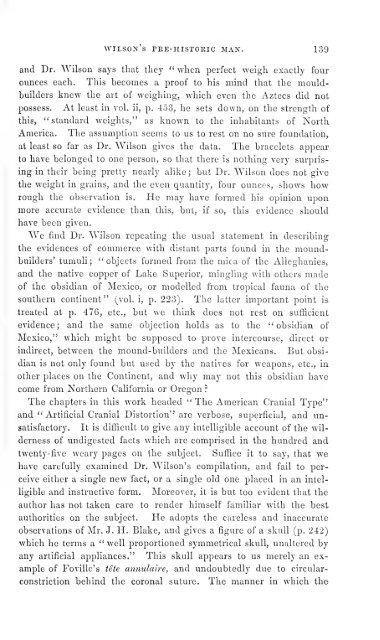The anthropological review - National Library of Scotland
The anthropological review - National Library of Scotland
The anthropological review - National Library of Scotland
You also want an ePaper? Increase the reach of your titles
YUMPU automatically turns print PDFs into web optimized ePapers that Google loves.
WILSON S PKE-HISTORIC MAN. 139<br />
and Dr. "Wilson says that they " when perfect weigh exactly four<br />
ounces each. This becomes a pro<strong>of</strong> to his mind that the mould-<br />
builders knew the art <strong>of</strong> weighing, which even the Aztecs did not<br />
possess. At least in vol. ii, p. 453, he sets down, on the strength <strong>of</strong><br />
this, " standard weights," as known to the inhabitants <strong>of</strong> North<br />
America. <strong>The</strong> assumption seems to us to rest on no sure foundation,<br />
at least so far as Dr. Wilson gives the data. <strong>The</strong> bracelets appear<br />
to have belonged to one person, so that there is nothing very surjjris-<br />
ing in their being pretty nearly alike ; but Dr. Wilson does not give<br />
the weight in grains, and the even quantitj', four ounces, shows how<br />
rough the observation is. He may have formed his opinion upon<br />
more accurate evidence than this, but, if so, this evidence should<br />
have been given.<br />
We find Dr. Wilson repeating the usual statement in describing<br />
the evidences <strong>of</strong> commerce with distant parts found in the mound-<br />
builders' tumuli; "objects formed from the mica <strong>of</strong> the AUeghanies,<br />
and the native copper <strong>of</strong> Lake Superior, mingling with others made<br />
<strong>of</strong> the obsidian <strong>of</strong> Mexico, or modelled from tropical fauna <strong>of</strong> the<br />
southern continent" (vol. i, p. 223). <strong>The</strong> latter important point is<br />
treated at p. 476, etc., but we think does not rest on sufficient<br />
evidence; and the same objection holds as to the "obsidian <strong>of</strong><br />
Mexico," which might be supposed to prove intercourse, direct or<br />
indirect, between the mound-builders and the Mexicans. But obsi-<br />
dian is not only found but used by the natives for weapons, etc., in<br />
other places on the Continent, and why may not this obsidian have<br />
come from Northern California or Oregon ?<br />
<strong>The</strong> chapters in this work headed " <strong>The</strong> American Cranial Type"<br />
and "Artificial Cranial Distortion" are verbose, superficial, and un-<br />
satisfactory. It is difficult to give any intelligible account <strong>of</strong> the wil-<br />
derness <strong>of</strong> undigested facts which are comprised in the hundred and<br />
twenty-five weary pages on the subject. Suffice it to say, that we<br />
have carefully examined Dr. Wilson's compilation, and fail to per-<br />
ceive either a single new fact, or a single old one placed in an intel-<br />
hgible and instructive form. Moreover, it is but too evident that the<br />
author has not taken care to render himself familiar with the best<br />
authorities on the subject. He adopts the careless and inaccurate<br />
observations <strong>of</strong> Mr. J. H. Blake, and gives a figure <strong>of</strong> a skull (p. 242)<br />
which he terms a " well proportioned symmetrical skull, unaltered by<br />
any artificial appliances." This skull appears to us merely an ex-<br />
ample <strong>of</strong> Foville's tete annulaire, and undoubtedly due to circular-<br />
constriction behind the coronal suture. <strong>The</strong> manner in which the

















